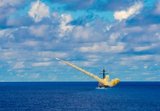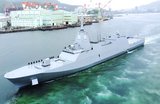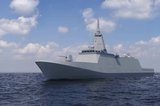Tomahawk Test Demonstrates Time-Critical Use
A US Navy Tomahawk Block IV cruise missile was launched during an operational test Nov. 5 which demonstrated the effectiveness of the missile’s new anti-jam GPS system and successful use against time-critical targets.
The Tomahawk Block IV was launched from the USS Princeton (CG-59), a Ticonderoga-class Aegis cruiser underway in the Pacific Ocean off the coast of Southern California. The missile flew a land attack mission into San Nicolas Island in support of a Special Operations team.
“This test proves that Tomahawk provides a key enabler for time-critical strike,” said Tomahawk Program Manager Capt. Dave Davison. “As the only network-enabled, land attack weapon, Tomahawk can re-target, loiter, or provide last minute weapons coverage to deployed forces from on-station naval combatants.”
The missile destroyed a time-critical target after receiving targeting information from a combined US/United Kingdom Special Operations Team on the island using the Precision Strike Suite – Special Operations Forces (PSS-SOF) and Joint Strike Planning and Execution Auto Router (JSPEAR) portable units. Live target updating was conducted from the field using these portable units and confirmation was provided by satellite and unmanned systems imagery.
The mission was initiated from JSPEAR and sent to the fleet commander and USS Princeton. Seconds after launch from the ship’s vertical launch system, the Tomahawk missile transitioned to cruise flight. The total flight time was short and the test was conducted to demonstrate the effectiveness of the Tomahawk’s new eight channel anti-jam GPS receiver (AGR-4). The results of this test confirmed the ability of Tomahawk Block IV to be used in time critical strike operations to meet the requirements of US Special Forces.
The Tomahawk is ship and submarine launched, and was first employed operationally during Desert Storm. The enhanced capabilities of Tomahawk Block IV increase fleet effectiveness, with network enabled communication, battle damage imaging, while at the same time significantly reducing acquisition and life cycle costs.
Tomahawk missiles are deployed throughout the world’s oceans. Tomahawk operational test launches are conducted throughout the year from Navy surface ships and submarines. These tests are designed to maintain the operational readiness of the Atlantic and Pacific fleets, as well as test and prove upgrades and enhancements to the missile, platforms, or control software.
The Tomahawk program, PMA-280, is managed by the Program Executive Office, Unmanned Aviation & Strike Weapons at Patuxent River, Md. The missile is manufactured by Raytheon Missile Systems in Tucson, Ariz. The weapon control system aboard the combatants is integrated by the Navy.
More from Naval Warfare
-
![Future of the Canadian Patrol Submarine Project is still unclear]()
Future of the Canadian Patrol Submarine Project is still unclear
The Canadian government remains tight-lipped on the timeline and funding required for the next steps of its Canadian Submarine Patrol Project, which should offer improved capabilities for the country’s navy.
-
![Mitsubishi eyes future with Australia’s Mogami selection]()
Mitsubishi eyes future with Australia’s Mogami selection
With Australia’s selection of the Mogami-class for Project Sea 3000, Mitsubishi is investigating local production in the next decade as potential export opportunities emerge.
-
![Royal Australian Navy sizes up modernisation plans for new and existing capabilities]()
Royal Australian Navy sizes up modernisation plans for new and existing capabilities
The Australian navy is pushing ahead with its efforts to modernise its workforce and capabilities while balancing risky submarine upgrades, ageing Collins-class boats and a shrinking minehunter fleet. Head of navy capability RAdm Stephen Hughes updated Shephard on the force’s progress.





















